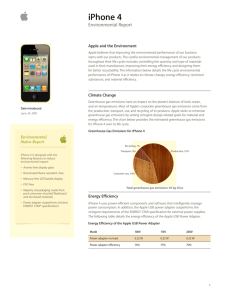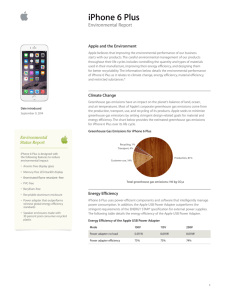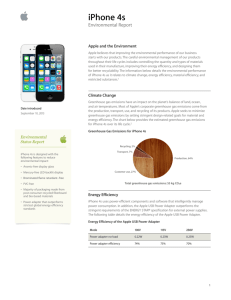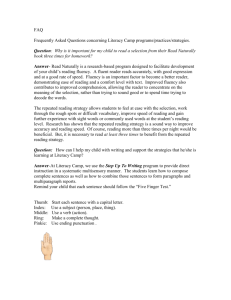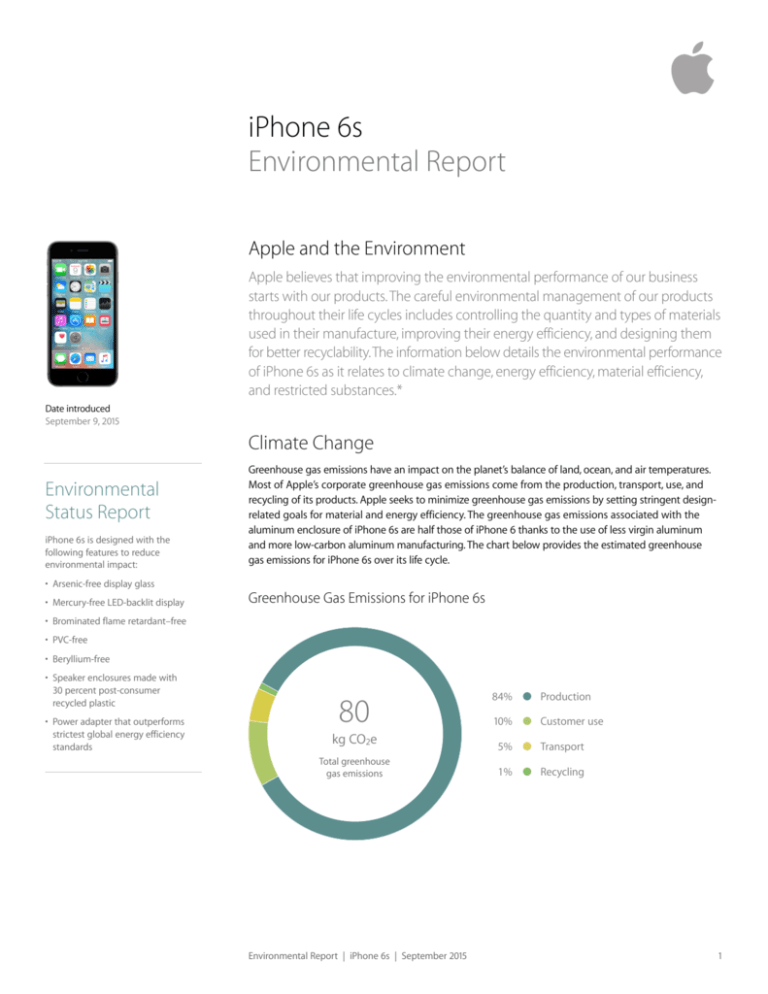
iPhone 6s
Environmental Report
Apple and the Environment
Apple believes that improving the environmental performance of our business
starts with our products. The careful environmental management of our products
throughout their life cycles includes controlling the quantity and types of materials
used in their manufacture, improving their energy efficiency, and designing them
for better recyclability. The information below details the environmental performance
of iPhone 6s as it relates to climate change, energy efficiency, material efficiency,
and restricted substances.*
Date introduced
September 9, 2015
Climate Change
Environmental
Status Report
Greenhouse gas emissions have an impact on the planet’s balance of land, ocean, and air temperatures.
Most of Apple’s corporate greenhouse gas emissions come from the production, transport, use, and
recycling of its products. Apple seeks to minimize greenhouse gas emissions by setting stringent designrelated goals for material and energy efficiency. The greenhouse gas emissions associated with the
aluminum enclosure of iPhone 6s are half those of iPhone 6 thanks to the use of less virgin aluminum and more low-carbon aluminum manufacturing. The chart below provides the estimated greenhouse gas emissions for iPhone 6s over its life cycle.
iPhone 6s is designed with the following features to reduce environmental impact:
• Arsenic-free display glass
Greenhouse Gas Emissions for iPhone 6s
• Mercury-free LED-backlit display
• Brominated flame retardant–free
• PVC-free
• Beryllium-free
• Speaker enclosures made with 30 percent post-consumer
recycled plastic
80
• Power adapter that outperforms
strictest global energy efficiency
standards
kg CO2e
Total greenhouse gas emissions
Environmental Report | iPhone 6s | September 2015
84% l Production
10% l Customer use
5% l Transport
1% l Recycling
1
Energy Efficiency
iPhone 6s uses power-efficient components and software that intelligently manages power consumption.
In addition, the Apple USB Power Adapter outperforms the strictest global energy efficiency standards.
The following table details the energy efficiency of the Apple USB Power Adapter.
Battery chemistry
• Lithium-ion polymer
Energy Efficiency of the Apple USB Power Adapter
• Free of lead, cadmium, and mercury
Mode
100V
115V
230V
Power adapter, no-load
0.011W
0.011W
0.011W
Power adapter efficiency
75.0%
75.0%
74.0%
Material Efficiency
Apple’s ultracompact product and packaging designs lead the industry in material efficiency. Reducing
the material footprint of a product helps maximize shipping efficiency. It also helps reduce energy
consumed during production and material waste generated at the end of the product’s life. iPhone 6s is
made of aluminum and other materials highly desired by recyclers. The chart below details the materials
used in iPhone 6s.
Material Use for iPhone 6s
29g l Display
26g l Battery
25g l Aluminum
Material Use
24g l Stainless steel
18g l Glass
11g l Circuit boards
7g l Plastic
3g l Other
Environmental Report | iPhone 6s | September 2015
2
Packaging
U.S. retail packaging of iPhone 6s
is 20 percent lighter and consumes
34 percent less volume than the
first-generation iPhone packaging.
The packaging for iPhone 6s is highly recyclable, and its retail box is made primarily from bio-based
materials, including fiberboard containing 90 percent post-consumer recycled content. In addition, the
iPhone 6s packaging is extremely material efficient, allowing 50 percent more units to be transported in
an airline shipping container compared to the first-generation iPhone. The following table details the
materials used in iPhone 6s packaging.
Packaging Breakdown for iPhone 6s (U.S. Configurations)
Material
Retail box
Paper (fiberboard, paperboard)
125g
High-impact polystyrene
28g
Other plastics
5g
Restricted Substances
Apple has long taken a leadership role in restricting harmful substances from its products and packaging.
As part of this strategy, all Apple products comply with the strict European Directive on the Restriction of the Use of Certain Hazardous Substances in Electrical and Electronic Equipment, also known as the
RoHS Directive. Examples of materials restricted by RoHS include lead, mercury, cadmium, hexavalent
chromium, and the brominated flame retardants (BFRs) PBB and PBDE. iPhone 6s goes even further
than the requirements of the RoHS Directive by incorporating the following more aggressive
restrictions:
• Arsenic-free display glass
• Mercury-free LED-backlit display
• BFR-free
• PVC-free
• Beryllium-free
Recycling
Through ultra-efficient design and the use of highly recyclable materials, Apple has minimized material
waste at the product’s end of life. In addition, Apple offers and participates in various product take-back
and recycling programs in 99 percent of the regions where Apple products are sold. All products are
processed in the country or region in which they are collected. For more information on how to take
advantage of these programs, visit www.apple.com/recycling.
Environmental Report | iPhone 6s | September 2015
3
Definitions
Greenhouse gas emissions: Estimated emissions are calculated in accordance with guidelines and requirements as specified by ISO 14040 and ISO 14044. Calculation includes emissions for the following life-cycle phases contributing to Global Warming Potential (GWP 100 years) in CO2
equivalency factors (CO2e):
• Production: Includes the extraction, production, and transportation of raw materials, as well as the
manufacture, transport, and assembly of all parts and product packaging.
• Transport: Includes air and sea transportation of the finished product and its associated packaging
from manufacturing site to regional distribution hubs. Transport of products from distribution hubs to end customer is modeled using average distances based on regional geography.
• Customer Use: User power consumption assumes a three-year period. Product use scenarios are based
on customer use scenarios. Geographic differences in the power grid mix have been accounted for at a
regional level.
• Recycling: Includes transportation from collection hubs to recycling centers, and the energy used in
mechanical separation and shredding of parts.
Energy efficiency terms: The energy efficiency values for the Apple USB Power Adapter are based on
the following conditions.
• Power adapter no-load: Condition in which the Apple USB Power Adapter is connected to AC power,
but not connected to iPhone.
• Power adapter efficiency: Average of the power adapter’s measured efficiency when tested at 100 percent, 75 percent, 50 percent, and 25 percent of the power adapter’s rated output current.
Restricted substances: Apple defines a material as BFR-free and PVC-free if it contains less than 900 parts
per million (ppm) of bromine and of chlorine. Apple defines a material as beryllium-free if it contains less
than 1000 parts per million (ppm) of beryllium.
✴Product evaluations based on U.S. configurations of iPhone 6s 128GB.
© 2015 Apple Inc. All rights reserved.
Environmental Report | iPhone 6s | September 2015
4




